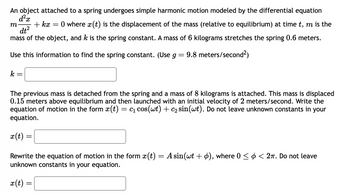Question

Transcribed Image Text:An object attached to a spring undergoes simple harmonic motion modeled by the differential equation
d²x
+ kx = 0 where x (t) is the displacement of the mass (relative to equilibrium) at time t, m is the
dt²
mass of the object, and k is the spring constant. A mass of 6 kilograms stretches the spring 0.6 meters.
Use this information to find the spring constant. (Use g = 9.8 meters/second²)
m
k =
The previous mass is detached from the spring and a mass of 8 kilograms is attached. This mass is displaced
0.15 meters above equilibrium and then launched with an initial velocity of 2 meters/second. Write the
equation of motion in the form x(t) = c₁ cos(wt) + c₂ sin(wt). Do not leave unknown constants in your
equation.
x(t)
Rewrite the equation of motion in the form ä(t) = A sin(wt + p), where 0 ≤ ☀ < 2π. Do not leave
unknown constants in your equation.
x(t)
=
Expert Solution
This question has been solved!
Explore an expertly crafted, step-by-step solution for a thorough understanding of key concepts.
This is a popular solution
Trending nowThis is a popular solution!
Step by stepSolved in 4 steps with 21 images
